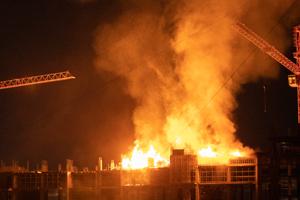Contractor training programs
The Occupational Safety and Health Administration (OSHA) standards require that workers obtain training regarding the existence of various workplace hazards and the equipment, programs and controls that should be in place to prevent workplace injuries from occurring. Some OSHA standards also require advanced training of supervisors who will be overseeing hazardous work, such as excavations, work being done at substantial heights, electrical work and work that involves confined space entry.
What does this cover?
Each OSHA standard contains a discussion on various hazards and controls. Sometimes the standard will also contain a specific requirement on training. There is an implicit requirement within the OSHA standards that employers train their workers so even if a standard does not have a statement, such as “you will provide training on…,” it is implied and required that you train your workers on all hazards of their work under 29 CFR 1926.21 — OSHA Construction Standards.
What else do I need to know?
You should write down a list of the type of work your company performs and the hazards and equipment that will be present. Some equipment, like ladders, will be used for various types of work and would be an obvious topic for all workers' training.
What about training?
Common training programs include:
New hire orientations — Designed to give workers new to a company or jobsite an overview of company safety policies, what to do in the event of an injury, where to get personal protective equipment (PPE) and how to protect themselves from the hazards they may encounter.
Equipment — Workers who will operate equipment must be authorized by their employer. It is a good practice to evaluate all operators (such as operators of forklifts, crane, heavy equipment, trucks) on their ability to operate your equipment. This also allows them to become familiar with the make, model, and type of specific equipment they will operate on your jobsite. Some equipment, such as cranes, requires certified operators.
Hazard-specific training — Certain OSHA standards require workers to be trained about the hazards they will face and the safety protection equipment they will use depending on the work they are performing.
Some of these are:
- Fall protection — Workers must be familiar with any personal fall protection equipment they will use (donning, inspection, attachment to structures, etc.).
- Excavations — Workers must be familiar with the hazards of excavation/trenching work and the protective systems that will be used.
- Confined space entry — Workers must be trained on the hazards of confined space work based on their role (entrant, attendant, and supervisor) and the safety equipment used for evaluation (air monitoring), permit systems and emergency response.
- Electrical — If workers will be “qualified” to work on energized equipment, they must be trained in the use of PPE, tools and hazards they may encounter (arc flash/blast).
- Hazardous chemicals — Workers must be trained on the chemicals they use, how to read Safety Data Sheets and labels, and how chemicals they come in contact with can potentially hurt them.
Where can I get more help?
The Hanover Risk Solutions website has additional materials you can use and the OSHA website has a page that is dedicated just for electrical safety information.
This material is provided for informational purposes only and does not provide any coverage or guarantee loss prevention. The examples in this material are provided as hypothetical and for illustration purposes only. The Hanover Insurance Company and its affiliates and subsidiaries (“The Hanover”) specifically disclaim any warranty or representation that acceptance of any recommendations contained herein will make any premises, or operation safe or in compliance with any law or regulation. By providing this information to you. The Hanover does not assume (and specifically disclaims) any duty, undertaking or responsibility to you. The decision to accept or implement any recommendation(s) or advice contained in this material must be made by you.
LC JAN 2019 12-372
171-1103 (10/14)
Related resources
Contractor training programs
The Occupational Safety and Health Administration (OSHA) standards require that workers obtain training regarding the existence of various workplace hazards and the equipment, programs and controls that should be in place to prevent workplace injuries from occurring. Some OSHA standards also require advanced training of supervisors who will be overseeing hazardous work, such as excavations, work being done at substantial heights, electrical work and work that involves confined space entry.
What does this cover?
Each OSHA standard contains a discussion on various hazards and controls. Sometimes the standard will also contain a specific requirement on training. There is an implicit requirement within the OSHA standards that employers train their workers so even if a standard does not have a statement, such as “you will provide training on…,” it is implied and required that you train your workers on all hazards of their work under 29 CFR 1926.21 — OSHA Construction Standards.
What else do I need to know?
You should write down a list of the type of work your company performs and the hazards and equipment that will be present. Some equipment, like ladders, will be used for various types of work and would be an obvious topic for all workers' training.
What about training?
Common training programs include:
New hire orientations — Designed to give workers new to a company or jobsite an overview of company safety policies, what to do in the event of an injury, where to get personal protective equipment (PPE) and how to protect themselves from the hazards they may encounter.
Equipment — Workers who will operate equipment must be authorized by their employer. It is a good practice to evaluate all operators (such as operators of forklifts, crane, heavy equipment, trucks) on their ability to operate your equipment. This also allows them to become familiar with the make, model, and type of specific equipment they will operate on your jobsite. Some equipment, such as cranes, requires certified operators.
Hazard-specific training — Certain OSHA standards require workers to be trained about the hazards they will face and the safety protection equipment they will use depending on the work they are performing.
Some of these are:
- Fall protection — Workers must be familiar with any personal fall protection equipment they will use (donning, inspection, attachment to structures, etc.).
- Excavations — Workers must be familiar with the hazards of excavation/trenching work and the protective systems that will be used.
- Confined space entry — Workers must be trained on the hazards of confined space work based on their role (entrant, attendant, and supervisor) and the safety equipment used for evaluation (air monitoring), permit systems and emergency response.
- Electrical — If workers will be “qualified” to work on energized equipment, they must be trained in the use of PPE, tools and hazards they may encounter (arc flash/blast).
- Hazardous chemicals — Workers must be trained on the chemicals they use, how to read Safety Data Sheets and labels, and how chemicals they come in contact with can potentially hurt them.
Where can I get more help?
The Hanover Risk Solutions website has additional materials you can use and the OSHA website has a page that is dedicated just for electrical safety information.
This material is provided for informational purposes only and does not provide any coverage or guarantee loss prevention. The examples in this material are provided as hypothetical and for illustration purposes only. The Hanover Insurance Company and its affiliates and subsidiaries (“The Hanover”) specifically disclaim any warranty or representation that acceptance of any recommendations contained herein will make any premises, or operation safe or in compliance with any law or regulation. By providing this information to you. The Hanover does not assume (and specifically disclaims) any duty, undertaking or responsibility to you. The decision to accept or implement any recommendation(s) or advice contained in this material must be made by you.
LC JAN 2019 12-372
171-1103 (10/14)
Related resources
Contractor training programs
The Occupational Safety and Health Administration (OSHA) standards require that workers obtain training regarding the existence of various workplace hazards and the equipment, programs and controls that should be in place to prevent workplace injuries from occurring. Some OSHA standards also require advanced training of supervisors who will be overseeing hazardous work, such as excavations, work being done at substantial heights, electrical work and work that involves confined space entry.
What does this cover?
Each OSHA standard contains a discussion on various hazards and controls. Sometimes the standard will also contain a specific requirement on training. There is an implicit requirement within the OSHA standards that employers train their workers so even if a standard does not have a statement, such as “you will provide training on…,” it is implied and required that you train your workers on all hazards of their work under 29 CFR 1926.21 — OSHA Construction Standards.
What else do I need to know?
You should write down a list of the type of work your company performs and the hazards and equipment that will be present. Some equipment, like ladders, will be used for various types of work and would be an obvious topic for all workers' training.
What about training?
Common training programs include:
New hire orientations — Designed to give workers new to a company or jobsite an overview of company safety policies, what to do in the event of an injury, where to get personal protective equipment (PPE) and how to protect themselves from the hazards they may encounter.
Equipment — Workers who will operate equipment must be authorized by their employer. It is a good practice to evaluate all operators (such as operators of forklifts, crane, heavy equipment, trucks) on their ability to operate your equipment. This also allows them to become familiar with the make, model, and type of specific equipment they will operate on your jobsite. Some equipment, such as cranes, requires certified operators.
Hazard-specific training — Certain OSHA standards require workers to be trained about the hazards they will face and the safety protection equipment they will use depending on the work they are performing.
Some of these are:
- Fall protection — Workers must be familiar with any personal fall protection equipment they will use (donning, inspection, attachment to structures, etc.).
- Excavations — Workers must be familiar with the hazards of excavation/trenching work and the protective systems that will be used.
- Confined space entry — Workers must be trained on the hazards of confined space work based on their role (entrant, attendant, and supervisor) and the safety equipment used for evaluation (air monitoring), permit systems and emergency response.
- Electrical — If workers will be “qualified” to work on energized equipment, they must be trained in the use of PPE, tools and hazards they may encounter (arc flash/blast).
- Hazardous chemicals — Workers must be trained on the chemicals they use, how to read Safety Data Sheets and labels, and how chemicals they come in contact with can potentially hurt them.
Where can I get more help?
The Hanover Risk Solutions website has additional materials you can use and the OSHA website has a page that is dedicated just for electrical safety information.
This material is provided for informational purposes only and does not provide any coverage or guarantee loss prevention. The examples in this material are provided as hypothetical and for illustration purposes only. The Hanover Insurance Company and its affiliates and subsidiaries (“The Hanover”) specifically disclaim any warranty or representation that acceptance of any recommendations contained herein will make any premises, or operation safe or in compliance with any law or regulation. By providing this information to you. The Hanover does not assume (and specifically disclaims) any duty, undertaking or responsibility to you. The decision to accept or implement any recommendation(s) or advice contained in this material must be made by you.
LC JAN 2019 12-372
171-1103 (10/14)
Related resources
Contractor training programs
The Occupational Safety and Health Administration (OSHA) standards require that workers obtain training regarding the existence of various workplace hazards and the equipment, programs and controls that should be in place to prevent workplace injuries from occurring. Some OSHA standards also require advanced training of supervisors who will be overseeing hazardous work, such as excavations, work being done at substantial heights, electrical work and work that involves confined space entry.
What does this cover?
Each OSHA standard contains a discussion on various hazards and controls. Sometimes the standard will also contain a specific requirement on training. There is an implicit requirement within the OSHA standards that employers train their workers so even if a standard does not have a statement, such as “you will provide training on…,” it is implied and required that you train your workers on all hazards of their work under 29 CFR 1926.21 — OSHA Construction Standards.
What else do I need to know?
You should write down a list of the type of work your company performs and the hazards and equipment that will be present. Some equipment, like ladders, will be used for various types of work and would be an obvious topic for all workers' training.
What about training?
Common training programs include:
New hire orientations — Designed to give workers new to a company or jobsite an overview of company safety policies, what to do in the event of an injury, where to get personal protective equipment (PPE) and how to protect themselves from the hazards they may encounter.
Equipment — Workers who will operate equipment must be authorized by their employer. It is a good practice to evaluate all operators (such as operators of forklifts, crane, heavy equipment, trucks) on their ability to operate your equipment. This also allows them to become familiar with the make, model, and type of specific equipment they will operate on your jobsite. Some equipment, such as cranes, requires certified operators.
Hazard-specific training — Certain OSHA standards require workers to be trained about the hazards they will face and the safety protection equipment they will use depending on the work they are performing.
Some of these are:
- Fall protection — Workers must be familiar with any personal fall protection equipment they will use (donning, inspection, attachment to structures, etc.).
- Excavations — Workers must be familiar with the hazards of excavation/trenching work and the protective systems that will be used.
- Confined space entry — Workers must be trained on the hazards of confined space work based on their role (entrant, attendant, and supervisor) and the safety equipment used for evaluation (air monitoring), permit systems and emergency response.
- Electrical — If workers will be “qualified” to work on energized equipment, they must be trained in the use of PPE, tools and hazards they may encounter (arc flash/blast).
- Hazardous chemicals — Workers must be trained on the chemicals they use, how to read Safety Data Sheets and labels, and how chemicals they come in contact with can potentially hurt them.
Where can I get more help?
The Hanover Risk Solutions website has additional materials you can use and the OSHA website has a page that is dedicated just for electrical safety information.
This material is provided for informational purposes only and does not provide any coverage or guarantee loss prevention. The examples in this material are provided as hypothetical and for illustration purposes only. The Hanover Insurance Company and its affiliates and subsidiaries (“The Hanover”) specifically disclaim any warranty or representation that acceptance of any recommendations contained herein will make any premises, or operation safe or in compliance with any law or regulation. By providing this information to you. The Hanover does not assume (and specifically disclaims) any duty, undertaking or responsibility to you. The decision to accept or implement any recommendation(s) or advice contained in this material must be made by you.
LC JAN 2019 12-372
171-1103 (10/14)





